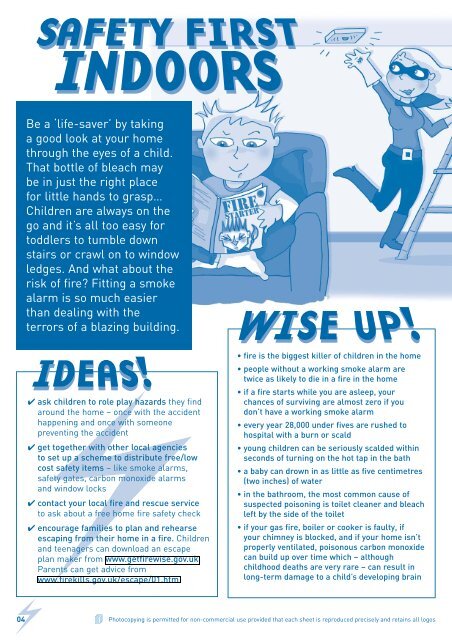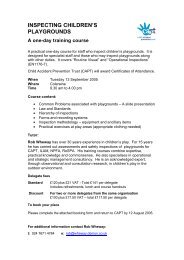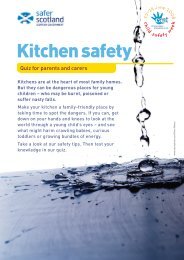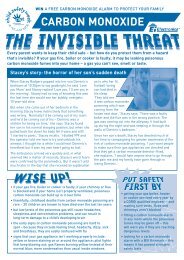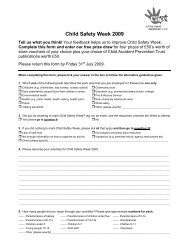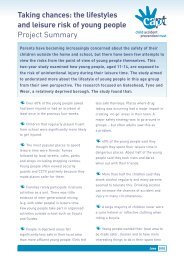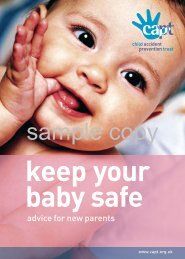Ideas booklet - Parent Directory
Ideas booklet - Parent Directory
Ideas booklet - Parent Directory
You also want an ePaper? Increase the reach of your titles
YUMPU automatically turns print PDFs into web optimized ePapers that Google loves.
Be a ‘life-saver’ by taking<br />
a good look at your home<br />
through the eyes of a child.<br />
That bottle of bleach may<br />
be in just the right place<br />
for little hands to grasp…<br />
Children are always on the<br />
go and it’s all too easy for<br />
toddlers to tumble down<br />
stairs or crawl on to window<br />
ledges. And what about the<br />
risk of fire? Fitting a smoke<br />
alarm is so much easier<br />
than dealing with the<br />
terrors of a blazing building.<br />
✔ ask children to role play hazards they find<br />
around the home – once with the accident<br />
happening and once with someone<br />
preventing the accident<br />
✔ get together with other local agencies<br />
to set up a scheme to distribute free/low<br />
cost safety items – like smoke alarms,<br />
safety gates, carbon monoxide alarms<br />
and window locks<br />
✔ contact your local fire and rescue service<br />
to ask about a free home fire safety check<br />
✔ encourage families to plan and rehearse<br />
escaping from their home in a fire. Children<br />
and teenagers can download an escape<br />
plan maker from www.getfirewise.gov.uk.<br />
<strong>Parent</strong>s can get advice from<br />
www.firekills.gov.uk/escape/01.htm<br />
• fire is the biggest killer of children in the home<br />
• people without a working smoke alarm are<br />
twice as likely to die in a fire in the home<br />
• if a fire starts while you are asleep, your<br />
chances of surviving are almost zero if you<br />
don’t have a working smoke alarm<br />
• every year 28,000 under fives are rushed to<br />
hospital with a burn or scald<br />
• young children can be seriously scalded within<br />
seconds of turning on the hot tap in the bath<br />
• a baby can drown in as little as five centimetres<br />
(two inches) of water<br />
• in the bathroom, the most common cause of<br />
suspected poisoning is toilet cleaner and bleach<br />
left by the side of the toilet<br />
• if your gas fire, boiler or cooker is faulty, if<br />
your chimney is blocked, and if your home isn’t<br />
properly ventilated, poisonous carbon monoxide<br />
can build up over time which – although<br />
childhood deaths are very rare – can result in<br />
long-term damage to a child’s developing brain<br />
04 Photocopying is permitted for non-commercial use provided that each sheet is reproduced precisely and retains all logos


